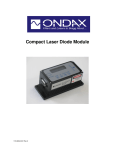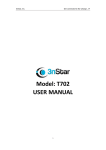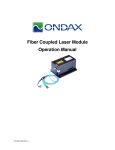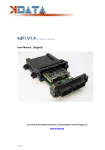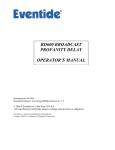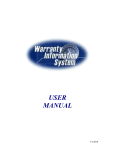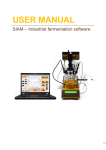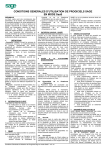Download Compact Laser Module Manual
Transcript
Compact Laser Diode Module 115-80040-001 Rev 9 Compact Laser Diode Module User Manual Contents 1 Safety Precautions ..................................................................................................................................... 3 2 Application and Features ........................................................................................................................... 5 3 Specifications ............................................................................................................................................. 5 4 Operating Procedures ................................................................................................................................ 8 5 Maintenance ............................................................................................................................................. 15 6 Service ..................................................................................................................................................... 15 2 Compact Laser Diode Module User Manual 1 Safety Precautions This instruction manual explains how to use the Compact Laser Diode Module. Before use, please read this manual thoroughly. After reading, keep it together with the product for reference when necessary. Please retain packaging material in the event the unit is stored or shipped in the future. Caution – use of controls or adjustments or performance of procedures other than those specified herein may result in hazardous radiation exposure. Body of the unit contains labels specifying wavelength and maximum emitted power. Recommend following user requirements for Class 3B products according to latest ANSI Z136.1 Standard for the Safe Use of Lasers. Use protective eyewear when engineering or other procedural and administrative controls are inadequate to eliminate potential exposure in excess of the MPE. Laser Diode Optical Feedback Warning Semi-conductor laser diodes are highly sensitive to optical feedback. They can suffer damage that maybe immediately apparent through loss in power or a reduction in life. Furthermore, wavelength stabilized laser diodes may lose their spectral characteristics such as center wavelength and linewidth if sufficient optical feedback exists. Your Ondax laser diode does not incorporate an optical isolator, so may be susceptible to extraneous optical feedback. We recommend the following precautions: • • • • If the output of the laser diode is collimated, all reflective surfaces in the optical path should be angled so that surface reflections would not be reflected back to the laser diode. Furthermore, since optimal alignment for interferometric measurement instruments is often achieved with the instrumentation optics at normal incidence to the laser, we recommend the use of optical isolators or slightly misaligning the instrument to avoid direct feedback into the laser. Beware of focusing the light output on a highly reflective/scattering surface. This is another means of generating high optical feedback to the diode. If fiber coupling, anti-reflective (AR) coated tips are recommended for multimode (MM) fiber. Angle polished tips and AR coating are recommended for single mode (SM) fiber. Beware of wavelength selective filters with narrow wavelength pass bands. Care should be taken not to align at normal incidence to the beam. Furthermore, be careful not to align the reflected light to be normal incidence during the alignment process (e.g. sweeping the beam back across the laser during alignment). If such a possibility is unavoidable, use a sufficient OD filter (or isolator) at the output of the laser diode during the alignment process. Please note that if sufficient additional feedback reaches the laser diode, it would overcome the grating-induced stabilization, unlocking and shifting the wavelength of the laser beyond the pass band of the filter. This will dramatically increase the reflected intensity back into the laser possibly causing damage. Optical Element 2 Optical Element 1 Collimating Lens Optical Element 1 Optical Element 2 Collimating Lens 3 Compact Laser Diode Module User Manual 1.1 Explanation of Warning Symbols The meaning of the symbols used in this manual and attached to the product follows. Warning messages are intended to prevent accidents to operating personnel such as burns and electrical shocks. Some caution messages are intended to prevent damage to the module. Precaution for handling electrostatic sensitive devices. Visible and/or invisible Class 3B laser radiation. Avoid direct exposure to beam. Wear suitable protective eyewear whenever laser is in operation. Laser output location warning. Warning To prevent permanent damage, observe these precautions: 1. Protect against electrostatic discharge. 2. Avoid external damage to the enclosure. 3. Use supplied power supply or power supply meeting specifications. 4. Do not drop the module or operate it at extreme temperatures or humidity. 5. Beware of optical feedback from reflective surfaces. Permanent damage to the laser diode is possible. 4 Compact Laser Diode Module User Manual 2 Application and Features 2.1 Applications This device is a compact laser diode module with integrated laser diode current driver and temperature control for high precision equipment and instrumentation. It plays a pivotal role in testing or manufacturing, and can be used in various applications such as Flow Cytometry, Confocal Microscopy, Protein Crystallography, DNA Sequencing, Semiconductor Defect Detection, Thin Film Analysis, High Density Data Storage, and Raman Spectroscopy. 2.2 Standard Features • Plug & Play Operation • Remote Computer Control Capability • ESD Protection • Built-in User Interface Panel • Constant Current Driver • Temperature Stabilized • Adjustable Output Power • LCD Display with Buttons for Adjusting Settings • Adjustable Temperature Setpoint • Compact Size • Remote Key Switch with Remote Interlock (Optional for OEM customers) 3 Specifications OPTICAL Power Stability (over 1 hr) < 1% Laser Noise ( 10 to 1Mhz) RMS < 1% Laser Class Class 3B (maximum power and wavelength listed on warning labels of the unit) Laser Operation CW Spatial Mode TEM00 Beam Divergence (full) < 1 mrad Beam Size at Aperture (FWHM) < 1 mm Beam Pointing Stability < ± 10 µrad Polarization (typical) > 100:1, vertical or horizontal Warm-up Time < 5 min ELECTRICAL Operating Voltage 3.3 V DC Operating Current 1.5 A max MECHANICAL Laser Dimension 40 mm x 42.5 mm x 100 mm Weight < 1 lb Operating Temperature +10ºC to +40°C Storage Temperature -40ºC to +80°C 5 Compact Laser Diode Module User Manual Figure 1: Mechanical Dimensions 6 Compact Laser Diode Module User Manual 7 6 1 Pins 1 2 3 4 5 6 7 8 9 Definition VCC TXD RXD GND TTL CON GND 2 8 3 9 4 5 Description Positive Power Pin +3.3V. Send data to computer (RS232) Receive data from computer (RS232) Not used GND for power and RS232 communication Outside TTL modulation Not used Not used GND for power and RS232 communication Note: Pinout is compatible with standard RS232 cable for interfacing with computer port or USB-RS232 adapter. Unit mates with a female DB9 connector. 2.1 x 5.5mm Center Positive Standard Jack for supplying operating voltage and current GND VCC Figure 2 – Electrical Connections Power LED: LED on indicates power on Laser LED: LED on indicates laser on Status LED: Meaning Rapid flashing (30 ms on / 30 ms off) Waiting for temperature to be stable after power on Fast flashing (100 ms on / 100 ms off) Waiting for 30 seconds Flash 1 time (200 ms on / 200 ms off) every 2 s (LED off) Running normally Flash 1 time (200 ms off / 200 ms on) every 2 s (LED on) Over current shut down Flash 2 times (20 0ms off / 200 ms on) every 2 s (LED on) Over temperature shut down Solid Waiting for settings change using push buttons 7 Compact Laser Diode Module User Manual 4 Operating Procedures 4.1 Standard CW Operation Laser module can be operated with or without RS232 communication port. Settings can be accessed via push buttons on the laser module as well as RS232 port. User Startup Procedure: • Properly mount laser module on a heat sink • If necessary, connect DB9 interface cable • Connect power supply Laser Module Startup Process: Laser module controller will follow/indicate the following process after power on: • With default shipping configuration of a password of 0000, system will automatically cycle through initialization routine and emit optical power. Changing the password from 0000 will cause the system to wait for password prior to completing initialization routine. Hence, default password of 0000 allows for hands off (computer control if needed) usage. Password other than 0000 would require user input prior to any computer communication or emission of light. • The power LED on indicates the controller has received power. Default operating conditions are stored in onboard flash. • The TEC activates to stabilize temperature to temperature setpoint. Setpoint can be changed via RS232 or push button interface. It will take a few seconds depending on the setting point and environmental conditions. During this period the status LED will flash rapidly. • Wait 30 seconds before the laser diode emits the power and the status LED will keep flashing fast. Laser controller only operates in constant current mode. Status LED flashes according to table above. Warning: Laser module will emit light 30 seconds after providing power. 4.3 Push Buttons and LCD Display The laser controller has 4 push buttons (“MENU”, “UP”, “DOWN”, “ENTER”) and a 2x16 LCD alphanumeric information display. . The pushbuttons are used to change various controller settings and laser operation parameters. “MENU” is used to enter or to exit the menu level. “UP” and “DOWN” are used for navigation and change values. “ENTER” chooses menu levels and confirms settings. • Version display. The LCD shows the software version information for 5 seconds when the unit power is on. Ondax SN:B099999 V3.27 • Entering password (if changed from default password of 0000). If password is entered incorrectly for three times, the unit would be locked until power is cycled (unplug and reconnect power cord). 8 Compact Laser Diode Module User Manual Ondax Password: 0002 • Wait for temperature stability after the unit power is on. Temperature setpoint is based on stored setpoint. Display shows actual temperature and TEC current: Wait TEC Setup 22.00ºC 100.00mA • Wait 30 seconds for temperature stability. Display shows time countdown: Wait (sec):30.0 22.00ºC 100.00mA • Main parameter display during normal operation. Display different operating parameter: • Normal run mode (constant current). Laser(I): 100.0mA 22.00ºC 200.0mA 100.00mA: laser operating current 22.00ºC: temperature, 200.00mA: TEC current • The parameter display can be cycled through the following modes by pressing “ENTER” Temp: 22.00ºC TEC Cur:200.00mA . Current:100.00mA Temp: • 22.00ºC Error Messages. Laser will display appropriate message if it reaches conditions that are unsafe. • Laser over current. Press “MENU”, and then press “ENTER” to reset the unit. Over Current Shutdown Restart • Over temperature shut down. Press “MENU”, and then press “ENTER” to reset the unit. 9 Compact Laser Diode Module User Manual Over temperature Shutdown Restart • Switching off • Both the laser and TEC drivers can be switched off by pressing “DOWN” while in normal mode. TEC,LD Operation Enter OFF_ After confirmation, the controller stops both drivers and it changes the screen to the following one. TEC & Laser OFF Any key restart The system will restart by pressing any pushbutton. • Settings Display The setting menu block is selected by pressing “MENU” in a normal running mode. Within the menu block, pressing “UP” or “DOWN” navigates between menu items. Press “ENTER” to select the item. Pressing “MENU” will exit the setting menu without saving the changes to flash. All the settings will go back to the previous setting after the unit is reset or re-powered. • Set TEC temperature Set TEC Temp 10-50ºC: 22.00 22.00: The previous set point Press “ENTER” to change the temperature set point. Otherwise press “UP” or “DOWN” to change the setting menu After pressing “ENTER” the unit will enter the parameter setting mode and the cursor will change from “S” to “2” which is the first digit of the parameter. Then press “UP” or “DOWN” to change the digit from “0” to “9” or “.”. After finished setting this digit, press “ENTER” to move to next digit. When you finish setting the last digit and press “ENTER” the parameter will affect right away then the cursor will revert to “S” at the same time. All the following parameter settings are the same. Set TEC Temp 10-50ºC: • 22.00 TEC Operation TEC Operation TEC Operation State: ON State: OFF 10 Compact Laser Diode Module User Manual Press “ENTER” to select TEC operation and the cursor will go down to the “O”. Then pressing the “UP” or “DOWN” will set TEC on or off. The TEC will not turn on or off until pressing “ENTER” to confirm the operation. Pressing “MENU” will cancel the change. All the following setups for selecting ON/OFF or Disable/Enable are the same as the TEC operation. • Set ACC Current Set ACC Current <=100.0mA:100.00 The maximum ACC current is the ACC full current. • • • Disable/Enable Laser ACC Driver ACC Operation ACC Operation State: Disable State: Enable On/Off Laser ACC Driver ACC Operation ACC Operation State: State: ON OFF Set Laser Current Limit Max Current Limit (mA): 400.00 If the laser current is over this value the laser will be shut down. • Change Password (default: 0000 will skip password entry on startup) Change Password Password: • 0000 Change Laser Run Mode Change Run Mode Run Default Mode Press “ENTER”, and then press “UP” or “DOWN” to change the run mode to “Internal Modulation” or “Default”. Settings change only takes effect when exiting the setting menu. “Internal Modulation” is unsupported and should not be used. 11 Compact Laser Diode Module User Manual • Save to flash and exit the setting menu Save to Flash and Exit All the setting parameters will be saved to flash memory. So the laser will keep this setting even when the unit is reset or repowered. 4.4 Operation via Communications Port The laser system includes complete remote control capability through RS232. All RS232 commands are available after laser system auto start. 4.4.1 Baud rates and serial port settings Each controller is shipped from the factory with a fixed 9600 baud, which cannot be changed. The other serial port parameters are: 8 data bits, 1 stop bit and no parity. A hardware flow control is not supported. 4.4.2 Command formatting and termination characters Each command to the controller must be terminated by a carriage return/line feed pair (ASCII 13 followed by ASCII 10). All commands are case-sensitive. Command arguments must be delimited by a single colon ‘:’ character (ASCII 58). 4.4.3 Handshaking Under no circumstances will the controller initiate communication. It only transmits characters in response to a message. Every message to the controller generates a response, either a numerical value or the acknowledgment string “OK”. In the event that the controller receives a message that it cannot interpret, it responds: “ERROR”. Every controller response is terminated by a carriage return/line feed pair (ASCII 13 followed by ASCII 10). 4.4.4 RS-232 Commands Commands Argument Response Function rlp? No **.** Return the laser output power in mW rli? No **.** Return the present operating current of the laser diode in mA rtt? No **.** Return the TEC present measured temperature of laser diode in degrees Celsius rti? No **.** Return the TEC present operating current in mA len No OK Enable laser APC driver ldis No OK Disable laser APC driver lon No OK Turn on the laser emission output power loff No OK Turn off the laser emission output power stt: **.** OK Set the TEC temperature in degrees Celsius(Default:22 Degree) 12 Compact Laser Diode Module User Manual slc: **.** OK Set ACC driver current in mA clfp: **.** OK Calibrate the laser power/Set the laser full power value in mW stm No OK Start inner TTL modulation ctm No OK Stop inner TTL modulation tecon No OK Enable TEC control tecoff No OK Shut down TEC control sps No OK Start APC power scan cps No OK Stop APC power scan slp: **.** OK Set the laser output power from 0.0 to full power(Default: Full power) rsv? No ****** Return the laser system firmware version stont: **.** OK Set inner TTL modulation on time, no less than 0.01ms stofft: **.** OK Set inner TTL modulation off time, no less than 0.01ms stsont: **.** OK Set power scan on time in ms, no less than 0.01 stsofft: **.** OK Set power scan off time in ms, no less than 0.01 ssps: *** OK Set APC power scan step rslp? No **.** Return the present laser setting power in mW rclp? No **.** Return the present laser full power rstt? No **.** Return the TEC set up temperature rstli? No **.** Return the ACC set up current in mA ssc No OK Save the setting to the flash memory so the laser system can operate in the same setting after repower it rlrs? No * smlc: **.** OK Read laser controller run status 1, Laser controller runs normally 2, Inner TTL modulation 3, Laser power scan 4, Waiting for calibrate laser power 5, Over laser current shutdown 6, TEC over temperature shutdown 7, Waiting temperature stable 8, Waiting 30 seconds Set the maximum laser diode current in mA, if the current is over the limit the laser will shut down. rlcm? No **.** Read the maximum laser current in mA reset No OK Reset the laser controller 13 Compact Laser Diode Module User Manual rsn? No ******* Return the laser controller serial number lcen No OK Enable ACC laser driver lcdis No OK Disable ACC laser driver lcon No OK Turn on ACC laser driver lcoff No OK Turn off ACC laser driver 4.5 Remote Key Switch Operation (Optional Only for OEM Customers) DB9 Connector to module. (Cable is included) 1. Power on/off key switch—Located on the front panel of the Remote Key Switch, this switch enables users to power the unit on with the turn of a key. The unit is inoperable when key is removed. 2. Emission indicator—This red LED, located to the upper right of the front panel, lights up when the unit is on to warn of eminent laser emission. 3. 5-second activation delay—The unit does not apply power to the laser module until five seconds after a user has turned the key switch to the “on” position. 4. Remote interlock & connector—This feature is located on the rear panel of the Key Switch. The unit will not operate without the interlock intact. Interlock needs to be shorted for power to be available for laser diode module. Remote Key Switch Procedure: • Plug power adapter into Remote Key Switch Box. Plug laser module into supplied DB9 – 2.1mm plug adapter cable. • Use key to activate and deactivate power to the laser module. After key switch is turned to “on” position , power will be available for the laser module after a 5 second delay. • Emission warning light will light up upon key switch turned to “on” position. 14 Compact Laser Diode Module User Manual • Laser system is “off” when key is in vertical position. • Interlock must be “shorted” for power to be applied to laser module 76mmLx45mmWx32mmT Original Power Supply for Module: Not connected when keyswitch is used. 135mmLx127mmWx65mmT ~1.5m 102mmLx65mmWx77mmT ~1.5m ~1.8m Illustration of Keyswitch with Module 5 Maintenance 5.1 Maintenance and Inspection Routine maintenance is not required. If the unit appears to be operating incorrectly or with low output power, check the following: • Inspect the enclosure for scratches, dings, dents, or other signs of damage due to handling. • Verify that the module enclosure has not been opened and the factory seal is intact. • Verify power source connections to the laser module. • Ensure that the operating environment is within specifications. 6 Service 6.1 Repair There are no user-serviceable parts inside and do not attempt to open housing. Warranty would not be valid if housing has been opened. If the module fails during use, check the items in section 5.1 before requesting an RMA. 15 Compact Laser Diode Module User Manual Defective modules that are beyond the warranty period will be repaired at cost, if possible. An RMA must be requested before sending it to Ondax. When shipping, please use a box at least five times as large as the module with enough packaging material to prevent any movement of the module within the box. 6.2 For Information or Enquiries If you need information regarding purchase or repair, or for any other Sales related questions, please contact the distributor or selling agent from whom the module was purchased. 6.3 Ondax Limited Warranty TM Ondax warrants that all SureLock integrated laser modules (RO, FCLM, LM) will be free from defects in material and workmanship for 12 months from the date of shipment. This limited warranty covers only those defects that arise as a result of normal use of the product, and does not cover any other problems, including those that arise as a result of: (i) improper handling, maintenance or modification, (ii) operation outside the product’s specifications; or (iii) unauthorized modification or misuse. If Ondax receives, during the applicable warranty period, notice of a defect in any product which is covered by this warranty, Ondax shall either repair or replace the product, at Ondax's option. Ondax shall have no obligation to repair, replace or refund until the customer returns the defective product to Ondax. Any replacement product may be either new or like-new, provided that it has functionality at least equal to that of the product being replaced. Ondax products may contain remanufactured parts, components, or materials equivalent to new in performance. Limitations of Liability 1. TO THE EXTENT ALLOWED BY LOCAL LAW, NEITHER ONDAX NOR ITS THIRD PARTY SUPPLIERS MAKES ANY OTHER WARRANTY OR CONDITION OF ANY KIND, WHETHER EXPRESS OR IMPLIED WARRANTIES OR CONDITIONS OF MERCHANTABILITY, SATISFACTORY QUALITY, AND FITNESS FOR A PARTICULAR PURPOSE. 2. TO THE EXTENT ALLOWED BY LOCAL LAW, EXCEPT FOR THE OBLIGATIONS SPECIFICALLY SET FORTH IN THIS WARRANTY STATEMENT, IN NO EVENT SHALL ONDAX OR ITS THIRD PARTY SUPPLIERS BE LIABLE FOR DIRECT, INDIRECT, SPECIAL, INCIDENTAL OR CONSEQUENTIAL DAMAGES, WHETHER BASED ON CONTRACT, TORT, OR ANY OTHER LEGAL THEORY AND WHETHER ADVISED OF THE POSSIBILITY OF SUCH DAMAGES. 3. To the extent allowed by local law, the remedies provided in this Limited Warranty Statement are the customer’s sole and exclusive remedies. 6.4 Contacting Ondax Ondax, Inc. 850 E. Duarte Rd. Monrovia, CA 91016 Tel: 626-357-9600 Fax: 626-357-9321 Web: http://www.ondax.com Email: [email protected] 16

















